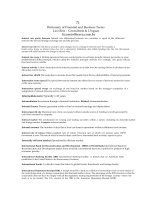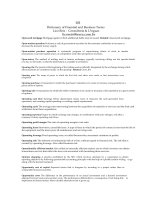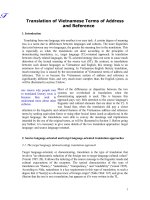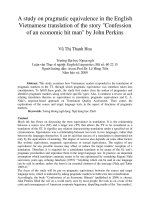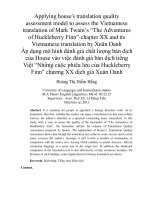Translation of vietnamese terms of address ppt
Bạn đang xem bản rút gọn của tài liệu. Xem và tải ngay bản đầy đủ của tài liệu tại đây (143.65 KB, 12 trang )
Translation of Vietnamese Terms of Address
and Reference
1. Introduction
Translating from one language into another is no easy task. A certain degree of meaning
loss is a norm due to differences between languages and cultures. The more disparities
that exist between any two languages, the greater the meaning loss in the translation. This
is especially so when the translations are done according to the principles of
domesticating translation, i.e., target language (TL)-oriented approach. In translation
between closely related languages, the TL-oriented strategy does not seem to cause much
distortion of the textual meaning of the source text (ST). By contrast, in translations
between such distant languages as Vietnamese and English, this strategy leads to an
enormous loss of original textual meaning. In Vietnamese-English literary translation,
much meaning loss is caused by the non-translation of Vietnamese terms of address and
reference. This is so because the Vietnamese system of address and reference is
significantly different from, and very much more complex than, the English system, as
will be illustrated in section 2 below.
Most of the differences or disparities between the two
systems are overlooked in translations when the
domesticating approach is used. This is because this
approach pays very little attention to the source language's
linguistic and cultural elements that are alien to the TL. It
was found that, when the translators did pay a closer
attention to the linguistic and cultural features of the Vietnamese address and reference
terms by seeking equivalent forms or using other lexical items (such as adjectives) in the
target language, the translations were able to convey the meanings and implications
intended by the use of the original terms, as will be illustrated in Section 5. Before going
any further, it is necessary to give some details of the two translation approaches: target
language- and source language-oriented.
2. Source language-oriented and target language-oriented translation approaches
2.1. The target language (domesticating) translation approach
Target language-oriented, or domesticating, translation is the type of translation that
involves "an ethnocentric reduction of the foreign text to target-language cultural values"
(Venuti 1995: 20). It allows the tailoring of the source message to the linguistic needs and
cultural expectations of the receptors. The typical characteristics of this type of
translation are "fluency," "naturalness," "transparency," and "readability" (Venuti 1995).
According to Nida, naturalness is a key requirement in this type of translation, to such a
degree that it "bear[s] no obvious trace of foreign origin" (Nida 1964: 167) and gives the
illusion that the text is not a translation, but appears as if it were written in the TL.
one reason why people turn
to translated literary texts is
because they seek to
understand more about other
cultures.
1
The concern with fluency and naturalness in TL-oriented translation means that it allows
alterations or adaptations of the SL items, such as "shifting word order, using verbs in
place of nouns, and substituting nouns for pronouns" (Nida 1964: 167). In other words, in
this type of translation the translator seeks dynamic equivalence (hence also referred to as
"dynamic-equivalence" translation (Nida 1964: 159)). Domestication also permits
adjustments to "special literary forms," "semantically exocentric expressions,"
"intraorganismic meanings" (Nida 1964: 170) and expansion of linguistic forms. If the
source text contains linguistic and cultural elements alien to the target language and
culture, they are likely to be avoided in the translation. In Anglo-Saxon translation this
approach is the predominant one, since English readers seem to be reluctant to read texts
that appear to be translations (Bassnett 1997).
2.2. The source language (foreignizing) translation approach
The source language-oriented method puts "an ethnodeviant pressure on [target-language
cultural] values to register the linguistic and cultural difference of the foreign text,
sending the [target] reader abroad" (Venuti 1995: 20). Using this method, the translator is
expected to preserve the foreign identity of the source text or, in other words, to preserve
the linguistic and cultural differences of the source text by seeking the "purely 'formal'
replacement of one word or phrase in the SL by another in the TL" (Hatim & Munday
2004: 40). Nida refers to this type of translation as "gloss translation," which is "designed
to permit the [TL] reader to identify himself as fully as possible with a person in the
source-language context, and to understand as much as he can of the customs, manner of
thought, and means of expression" and which may "require numerous footnotes in order
to make the text fully comprehensible" (Nida 1964: 159). Such footnotes can disrupt the
flow of the text. For this reason, the foreignizing approach is not commonly utilized.
However, formal-equivalence translations are useful in situations where essential
elements of the narrative would be lost by use of the dynamic-equivalence approach.
Detailed illustrations are provided in Section 4 below, but first, it is necessary to provide
a brief overview of the Vietnamese system of address and reference.
3. Overview of the Vietnamese system of address and reference
In comparison with English, the Vietnamese system of address and reference is much
more diversified and intricate. According to Luong, for example, English I and you,
"have as their counterparts in the Vietnamese system dozens of linguistic forms of
various grammatical subclasses" (Luong 1990: 2). These include personal pronouns,
kinship terms, status terms, and proper nouns (personal names) (Luong 1990; Cooke
1968; Nguyen 1999; Cu 2001). All can be "alternatively used to refer to the addressor,
the addressee(s), as well as third parties in social interactions" (Luong 1990: 4).
2.1. Personal pronouns
2
In the domain of the personal pronouns, Vietnamese has more forms than English does,
as shown in Table 1.
Table 1: Vietnamese personal pronouns
Persons
Number
P1 (addressor)
(English "I/we")
P2 (addressee)
(English "you")
P3 (third person
referent) (English
"he, she, it/they")
toi /
no, han, y Singular
tao may, mi
ta /
To /
minh /
/ mih
chung toi /
chung no, chung, ho
Plural
chung tao chung may,
bay,
chung bay
ta/ chung ta
chung to /
minh, chung minh /
3
As can be seen from Table 1, there are five common pronouns for 1
st
person singular
reference. The corresponding plural forms for the five singular pronouns are created by
the addition of chung to the singular forms, except for minh and ta, which can also be
used in plural reference. In the 2
nd
person, there are three singular and three
corresponding plural forms. Not all 1
st
person personal pronouns have corresponding
personal pronouns in the 2
nd
person reference system. Except for tao, which can be used
reciprocally with 2
nd
person pronoun (may or mi), the others are commonly paired with
kinship terms, status terms, or even personal names. The 3
rd
person reference includes
four commonly used pronouns in the singular forms and three in plural.
In most cases, the use of Vietnamese personal pronouns pragmatically implies either
intimacy/familiarity, among close friends of the same age, or a lack of deference and high
degree of arrogance towards the addressee and/or third-party pronominal referent of
superior age. As such, they are normally used in informal situations. The only personal
pronoun that can be used in formal situations is toi. This is the most neutral term to be
used in social situations. However, according to Luong, if used among family members,
toi as well as the other Vietnamese personal pronouns "presuppose and imply not only
the negation of solidarity but also the lack of deference towards the referent" (Luong
1990: 129).
2.2. Kinship terms
Kinship terms, used pronominally, constitute a much more important part of the
Vietnamese system of address and reference than personal pronouns. According to
Cooke, "these are nouns, most of which have a primary meaning denoting blood kin"
(Cooke 1968: 125). They appear so frequently and are so varied and diversified that "not
only do they impose difficulty for foreign learners of Vietnamese, but sometimes it is
also hard for Vietnamese people to use them properly and appropriately" (Nguyễn 1999:
170) (my translation). Luong observes that "Vietnamese kinship terms are used not only
for third-party reference, but pervasively also in address and self-reference" (Luong
1990: 37) among related people, as well as non-relatives, to express various degrees of
meaning, from high disrespect to great respect, and from a high level of intimacy to
extreme distance.
Vietnamese has equivalents of most of the kinship terms that are available in English. It
also has many terms for which English does not have equivalents, such as those which
translate as 'younger uncle', 'older aunt', 'maternal sister', 'paternal brother', and 'male
cousin', to name just a few. It is beyond the scope of this paper to provide a detailed
account of all the kinship terms available in Vietnamese. However, Table 2, adapted from
Cooke (1968), summarizes the meanings and usages of the Vietnamese kinship terms.
Table 2: Meanings and usages of Vietnamese kin terms
4
Term Literal meaning Usages
In both 1
st
& 2
nd
persons
In 1
st
person
In 2
nd
person
co
great-great
grandparent
Very elderly person to or by
much younger person
To a very elderly
person
cu
great
grandparent
Very elderly person to or by
much younger person
To a very elderly
person
ong
grandfather
(great uncle)
Male about grandparent's age
to or by young person
Male
(arrogant)
Among male equals
ba
grandmother
(great aunt)
Female about grandparent's
age to or by young person
Female
(arrogant)
Among female
equals
bo/
cha
father Father to or by offspring
Young man
(humorous,
ironical)
me mother Mother to or by offspring
Young woman
(humorous,
ironical)
bac
parent's elder
sibling, or
cousin
Person parent's age or above
to or by young person
Person speaker's
age or above
cô
father's younger
sister/female
cousin
Woman parent's age or under
to or by child
Woman younger
than speaker
chu father's younger Man parent's age or under to
Man younger than
5
brother/male
cousin
or by child speaker
cau
mother's
younger
brother/male
cousin
Man parent's age or under to
or by child
Intimate friends
Man younger than
speaker
anh
elder brother or
male cousin
Husband to or by wife
Older male to or by younger
person
Male equals
(general)
chi
elder sister or
female cousin
Older female to or by
younger person
Female equals
(general)
em
younger sibling
or cousin
Wife to or by husband
Younger female by or to
older person
Younger
to older
Man and woman
younger than
speaker (intimate)
con offspring
To or by person about same
age as offspring
chau
grandchild,
nephew, niece
To or by person much
younger than speaker
(Adapted from Cooke 1968: 135)
(All these kinship terms can also be used for 3
rd
person reference).
Apart from personal pronouns and kinship terms, Vietnamese people also use status
terms (occupational titles); e.g., dong chi ('comrade'), giao su ('professor'), or bac si
('doctor'), and personal names as modes of address and reference. In Vietnamese, status
terms and personal names are used to address others and to refer to oneself more
commonly than in English.
2.3. Socio-cultural features of the use of Vietnamese terms of address and reference
6
The use of Vietnamese terms of address and reference in actual communication is
extremely intricate. As Luong points out:
Both the use and the meanings of Vietnamese person-referring forms are
saliently and inextricably linked to the power, solidarity, and formality
dimensions in the relations among the addressor, addressee, as well as the
referred parties (Luong 1990: 5).
The appropriate choice of terms to utilize involves consideration of a wide range of
sociolinguistic factors, such as the age, sex, social status, relationship (blood, intimate, or
distant), attitudes (respectful or arrogant), and feelings of the speaker and addressee, as
well as the formality of the communication context (Luong 1990; Nguyen 1999). The
attitudes and feelings of the speaker and addressee also play an important role in the
choice of address and reference terms. A shift in an interactant's choice of address or
reference term will simultaneously signal a change in his/her attitude or feelings towards
his/her interlocutor.
The use of Vietnamese terms of address and reference in literature is particularly
interesting. A close study of four short stories and selected chapters from two novels
found that the terms are utilized abundantly, flexibly, and with great talent to describe the
characters' personalities and relationships between the characters, to signal the subtle
changes in their relationships, as well as their attitudes towards each other, and to
manipulate the writer's attitudes and feelings towards his/her characters. The meanings
and implications conveyed by the writer through his/her use of address and reference
terms contribute considerably to the overall complexity and subtlety of the text.
It was found that dynamic-equivalence translations of most of the terms made it
impossible for target readers to have the same understanding and feeling about the target
text as readers of the source text. Examples in section 4 below illustrate this. The
examples are representatively taken from the data corpus of the study.
4. Failure of the target language oriented (dynamic-equivalence) translation to
create an equivalence effect
As discussed in section 2.1 above, the TL-oriented translation approach claims to achieve
an equivalence effect, i.e., the effect the target text has on the target readers is expected to
be similar to that created by the source text on the original readers. However, most of the
dynamic-equivalence translations of the Vietnamese terms of address and reference in the
literary works analyzed resulted in a great loss of socio-cultural meanings and also, in
many cases, pragmatic implications that were exclusively manipulated through the use of
the terms, thus making equivalence effect impossible. The following examples show the
failure of domesticating approach in creating an equivalence effect.
1a. Toi khong tha thu đau (WK)
7
I no forgive [negation particle]
I won't forgive
1b. Con xin loi bo (WK)
Child beg mistake/apologize father
I'm sorry, Father
Both 1a and 1b are from an exchange between the father and his son in the short
story 'Without a King' after the son caught the father peeping at his daughter-in-
law in the bath. Being really upset by, and angry at, the father's inappropriate
behavior, the son uses the distant and disrespectful pronoun toi ('I') for self-
reference at the beginning of their talk (1a). The use of the self-reference personal
pronoun toi by a child to his/her parent implies a high degree of disrespect, a lack
of solidarity, and a temporary negation of the blood relation. The son's use of toi
in this situation expresses his extreme disgust towards his father's inappropriate
behavior. After their man-to-man talk, which makes the son understand his father
better and leads him to sympathize with and feel more love and respect for his
father, he shifts to the intimate, respectful, and affectionate kinship term con
('child'). Since both toi and con are rendered as 'I', the target reader is unable to
experience the shift. Although target readers may be able to understand the
change in the son's attitude towards his father through his apology, it is
impossible for them to comprehend the son's significant sway in his feeling in the
same way as it could be understood by original readers, since the contrast between
toi and con is not communicated in the translation.
In the following examples from "The Sorrow of War," the subtle change in the
character's feeling and attitude is communicated exclusively through the shift of
address and reference terms and there are no other clues in the text. The dynamic-
equivalence translation of the terms leaves target readers completely unaware of
the change. In these examples, Hanh, a female character who normally calls Kien,
the main male character, 'younger brother' and refers to herself as 'older sister',
which indicates that she normally treats him as a little friend or little brother,
changes her address and reference terms to Kien to imply her wish to change their
relationship.
2a. Nhung de chi thu xem da. Co khi phai nho em xe ho may bac de len
xuong cho nhanh
But let older sister try see [final particle]. Maybe have to ask younger
brother dig help some steps so go up down quickly
But let me try first. We might need some steps for me to get down into
it easily
8
2b. Kien? Cho minh len voi Minh can noi voi Kien dieu nay ('Sorrow
of War': 71)
Kiên? For self up [final particle] Self need speak with Kiên thing this
Kiên, Please help me There's something I want to tell you
In 2a Hanh refers to herself using chi ('older sister') and addresses Kien as em
('younger brother/sister'), still treating him as a close younger brother. After their
accidental body contact inside the shelter, she suddenly shifts to pronoun minh
('self') as self-reference and addresses Kien by name. This abrupt shift is meant to
eliminate the age gap between them and by it Hanh sends Kien a clear signal that
she is interested in him and wants to establish a more-than-friendly relationship
with him. While original readers can easily understand Hanh's intention through
her shift of address and reference terms, the translation forms I and you result in
the loss of all this information.
5. Source language oriented (formal-equivalence) translation and equivalent
effect
Formal-equivalence translation, in most cases, succeeds not only in transferring
the linguistic forms of the original terms, but also in conveying the intended
meanings and implications of the terms, thus creating an equivalent effect. See
examples 3 (taken from "A Marker on the Side of the Boat") and 4 (taken from "A
Novel Without a Name") below.
3. Anh phai an di mot ti da
Older brother have to eat little already
Eat some, Brother (p 12)
4. Chao dong chi
Greet comrade
Hello, comrade
The interaction in 3 takes place between a young girl and a soldier in the Vietnam
War against the Americans. The interactants barely know each other; the soldier
collapses under the roof of the girl's house and is saved by her. The girl addresses
him using the intimate and respectful term anh ('older brother'), showing her close
feeling for him as that for a brother. The equivalent form brother given in the
9
translation is successful in conveying not only the linguistic form, but also the
implication of the original term; i.e., this translation form can give target readers a
feeling that the girl is treating the soldier warmly as a family member.
Similarly, the formal-equivalence translation of the original term dong chi
('comrade') in example 4 is another successful attempt to transfer the linguistic
and cultural elements of the original term.
Although these equivalent forms may not sound very natural in English in such
situations, they do not make the target text (TT) non-fluent, neither do they cause
any disruption to the flow of the text, yet they successfully accommodate the
linguistic and cultural differences of the source text. However, a close study of the
texts examined reveal that such attempts at producing formal-equivalence
translations are very rare. This is understandable, since giving equivalent forms to
all the original address and reference terms would produce a highly unnatural and
non-fluent target text because doing so would frequently require numerous
footnotes or bracketed explanations to make the TT comprehensible and
intelligible. Nevertheless, where textual meaning of the source text (ST) is
exclusively manipulated through shifts of terms such as the ones exemplified in 1
and 2 above, it is important that the linguistic elements, meanings, and pragmatic
implications of the terms and/or the shifts be conveyed in the translation. How
could this be done so that the translation is not excessively foreign sounding?
Section 6 below offers a solution to this problem.
6. A suggested strategy when translating Vietnamese terms of address and
reference to English
As stated in Section 2, the target language oriented translation approach permits
expansion of linguistic forms. It is thus suggested that where there is a need for
the linguistic and cultural elements of the original terms to be conveyed in the
translation, it could be done by giving the equivalent forms in the target language
and providing information about the meaning and implications of the use of the
term (or change of terms) in the body of the text as part of it, instead of in
footnotes or bracketed notes. Take for example the change of address and
reference term by Hanh with Kien in "The Sorrow of War," exemplified in 2a and
2b.
As was seen, the shifts of Hanh's address term to Kien from em to Kien and
reference term from chi to minh in the original are not reflected in the translation.
These original shifts could be given equivalent forms in English, as shown in the
gloss translation of the examples, thus having 2a and 2b translated as followed:
2a. "But let your older sister try first. I might need to ask my younger
brother to dig some more steps for me to get down into it easily"
10
2b. "Kiên, Please help me (self) There's something I (self) want to tell
you, Kiên"
2a could then be followed by something like "Hanh still treats Kien as a little
younger brother, thus when speaking to him still considering herself as his sister."
Since 'younger brother' used by Hanh to address Kien and 'sister' by Kien to
address Hanh already appeared earlier in the translation version, their occurrence
in these sentences would not be ambiguous and misleading to the target reader.
After "Kien, Please help me (self)" in 2b, it would be necessary to add
something like "here Hanh ceases to consider Kien as her 'younger brother' and
herself as his 'older sister', beginning to call him by his name alone and using a
different term, minh, to refer to herself, thus revealing a much more personal,
intimate, and affectionate attitude, which clearly sends Kien a signal that she is
interested in him and wants to have a closer, more-than-friendly relationship with
him." Such a translation, although not as natural and transparent as a fully
dynamically equivalent strategy, would not interrupt the flow of the narrative or
be ambiguous, and it would successfully convey the subtle and important change
signified by the shift of self-reference terms in the original. This is a type of
translation where elements of the domesticating translation approach are brought
into the foreignizing translation environment.
7. Conclusion
It is widely agreed that a certain degree of meaning loss in translation is, as Nida
puts it, "inevitable," since "a translator can rarely do complete justice to the total
cultural context of the communication, to the emotive features of meaning, and to
the behavorial elements [of the source text]" (Nida 1964: 175). This is especially
so if the translator uses the target language-oriented approach, which adheres
closely to the linguistic and cultural norms of the target language and produce a
natural and transparent target text which does not appear as translation, but rather
as an original text. In translation between closely related languages and cultures,
the loss may be minimal. However, between such distant languages and cultures
as Vietnamese and English, the loss, as demonstrated above, can be significant.
This is because much of the textual meaning of the Vietnamese texts is expressed
through the use of the address and reference terms, which are very different from
the English terms. The meanings and implications manipulated through the use of
the Vietnamese terms play a crucial role in building an adequate understanding of
the text. This is especially so when changes in the characters' feelings and
attitudes towards each other or in their relationships are conveyed through
changes in address and reference terms.
It is therefore suggested that practicing translators may need to pay more attention
to the need to accommodate the linguistic and cultural elements of the source text
in their translations. Not only will doing so lead to a better understanding of the
original text, but it will also provide the target reader with enhanced knowledge of
11
the customs and culture of another nation. After all, one reason that people turn to
translated literary texts, apart from leisure reading, is because they seek to
understand more about other cultures.
12


